Palestrina's Pieta: the most famous work not by Michelangelo
It was 1756 when the Prenestine historian Leonardo Cecconi, in his Storia di Palestrina (History of Palestrina), gave an account of a Pietà that was then in the church of Santa Rosalia, and to be precise in the Barberini chapel: it was described as “a statue representing the grieving Virgin with the dead Jesus in her bosom,” but above all it was referred to, for the first time ever, as a “sketch by the famous Buonarroti.” Thus begins the story of the so-called Palestrina Pietà , one of the most discussed works of the 16th century. And the reason why so much discussion has arisen around this singular sculpture is quickly said: despite the fact that many have attributed it to Michelangelo (Caprese, 1475 - Rome, 1564), contemporary sources are silent on the matter. There are no documents from Michelangelo’s time that mention it, and none of his biographers mention it: in fact, if it were indeed a work by the great Tuscan artist, it would be the only Pieta that none of his contemporaries ever wrote about.
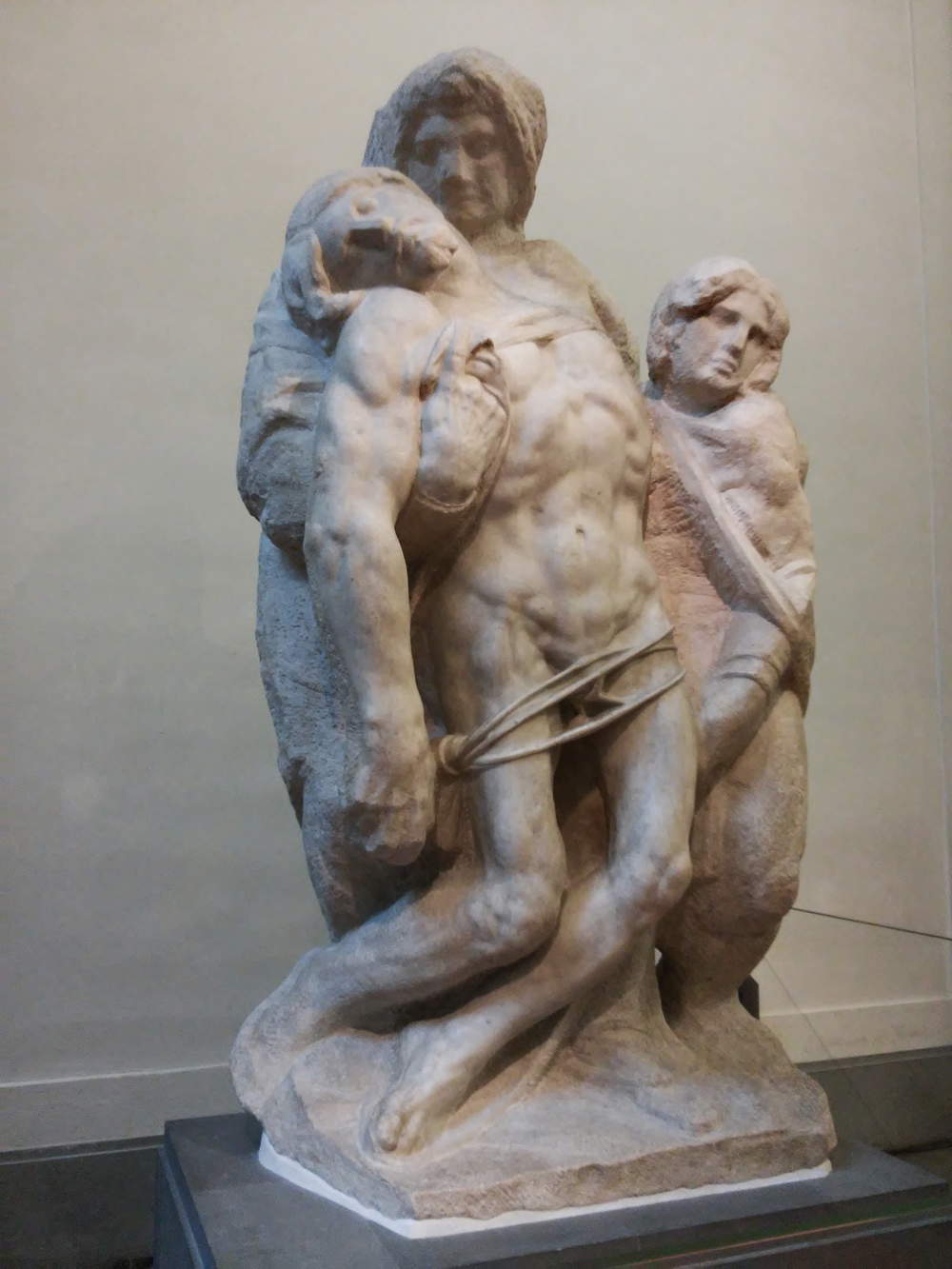 |
| Attributed to Michelangelo, Palestrina Pieta (c. 1547-1559; marble, height 251 cm; Florence, Galleria dell’Accademia) |
Of course, we also have no idea how the work could have ended up in the church of Santa Rosalia in Palestrina. All we know is that it was there at the time Cecconi was writing his History, and that it remained there until 1939, when it became part of the collection of the Galleria dell’Accademia in Florence, where it is still kept today (to be exact, it is in the Galleria dei Prigioni: it is the last sculpture we see before the David). The entry took place, moreover, in a rather “suffered” way: reconstructing the story in detail was, in 2011, art historian Adriano Amendola. The Barberini family, which was going through a period of severe economic crisis, had decided a few years ago to sell several pieces of its collection in order to obtain liquidity: among the works destined to end up on the market was the Palestrina Pietà . Maria Barberini, princess of Palestrina, began making arrangements with a German dealer, Rudolf Heinemann, to negotiate the sale of the sculptural group, whose final destination would be the Metropolitan Museum in New York. The state, however, blocked the export: the commission that evaluated the case was in fact reluctant to let the work leave Italy. Not only because they did not want to deprive themselves of a work by Michelangelo (at the time many were inclined to believe the work to be by the hand of the master, although many doubts had already been raised), but also because the affair soon became a political case. ForFascist Italy, it would have been a bad move to let the work end up in the United States: the risk lay in the fact that the transfer could have passed as a sign of weakness in foreign policy. Moreover, acquiring it and displaying it in an Italian museum would have been an effective propaganda move favorable to the regime. The problem was that the state had no money to spend to buy the work: as Amendola recalls, Mussolini therefore had the idea of “kindly inviting” the Lombard (but adopted Genoese) industrialist Gerolamo Gaslini, at the time a defendant in a tax fraud trial, to pay the sum for the purchase of the Pieta (four and a half million liras). Gaslini negotiated directly with Mussolini and delivered the money to him: the dictator passed off the work’s entry into the state collections as his munificent gift (in a well-known article on sculpture written in 1939 by the great art historian Pietro Toesca, who was part of the aforementioned commission, we read: “A masterpiece by Michelangelo is donated to Italy by the DUCE, a devout offering to Him of a citizen who wants to keep silent even his own name”) and could thus also pass as, in Amendola’s words, “savior of the artistic heritage expression of Italian civil identity.”
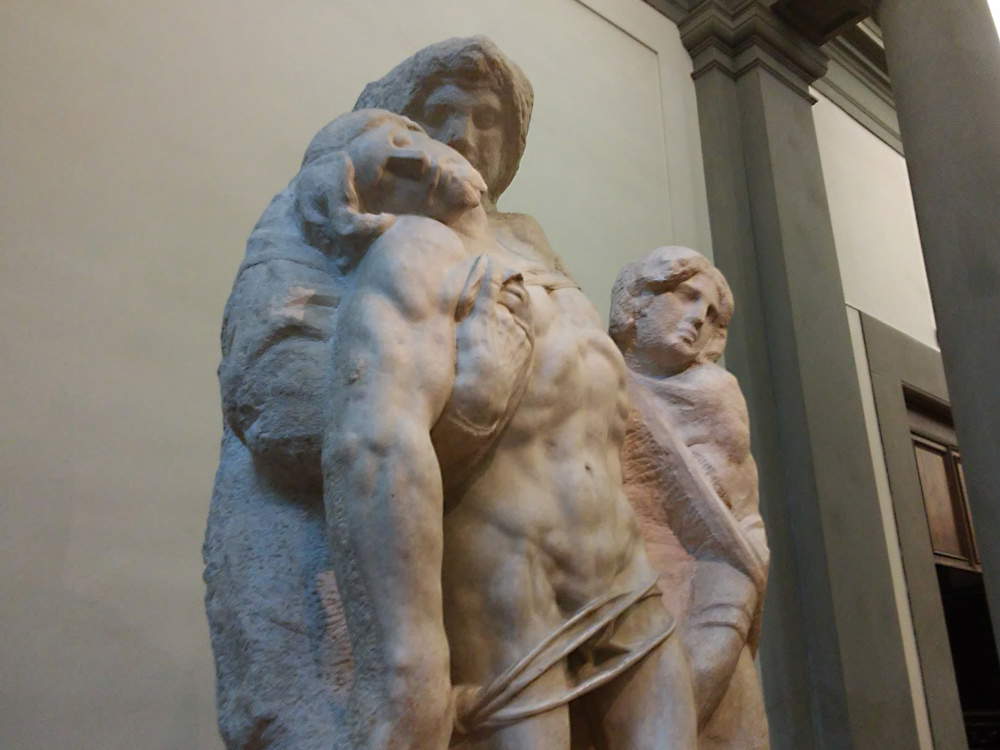 |
| Detail of the Palestrina Pietà |
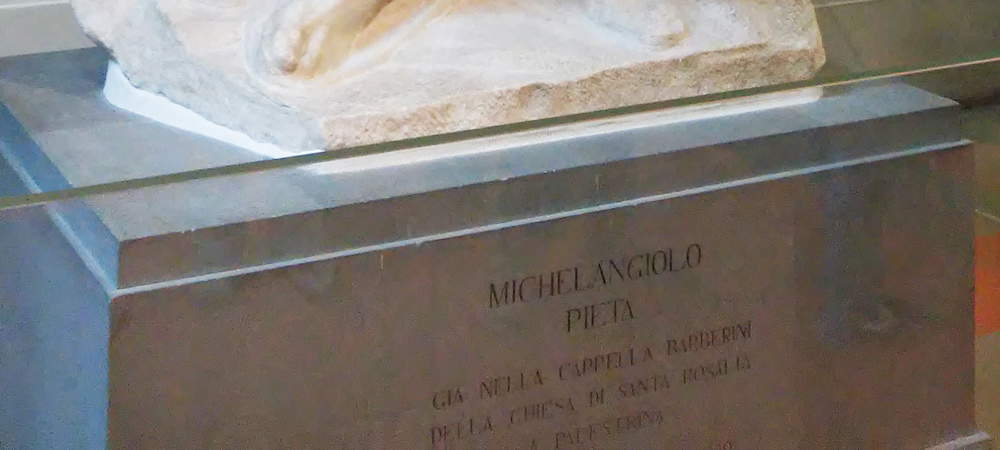 |
| The base of the sculpture with the attribution to Michelangelo |
Since 1939, as mentioned, the Palestrina Pieta has been showing itself to the eyes of the enchanted visitors of the Galleria dell’Accademia in Florence, and since then the question buzzing in the minds of those who observe it is, “but is it really a work by Michelangelo?” Of this opinion were, in addition to the earliest commentators such as the Cecconi mentioned at the beginning, some of the greatest art historians of the first half of the twentieth century. Before analyzing the positions of the critics, however, let us try to take a closer look at this enigmatic sculptural group. The work consists of three figures: the Virgin and Jesus, as per the more classical iconography of the Pieta, and a third figure on the right, whose identity is not easily discernible. Its proportions appear more slender than those of the energetic Madonna whose nervous, masculine hand supports the muscular body of her son: the features appear effeminate, so the first scholars who dealt with the Palestrina Pietà thought it was the Magdalene, a character who, after all, always appears in the scenes of the mourning over the dead Christ (it is less frequent, however, to find her in the Pietà ). But the hypothesis that would like to identify in the character on the right the figure of St. John the Evangelist, the youngest of Christ’s apostles, who in the iconographies of mourners, last suppers and in general evangelical episodes in which he is present, is always distinguished by his ephebic and very delicate features, should not be discarded either.
Looking at the work we can see many interesting details. What perhaps strikes us most is the fact that the work is in a sketchy state, as Leonardo Cecconi also noted. The back side is completely smooth (the work was to be set against a wall, a position in which it was actually located in the Prenestine church), but some perforations and remnants of certain decorative motifs would suggest that the piece of marble from which the sculpture was carved was anciently an element inserted into a larger complex: a sign that the sculptor who made the Pieta did not work on a marble that came directly from a quarry, but on what was most likely the fragment of an architrave belonging to an ancient architecture (this would not, after all, be a rare case). There are many details that seem barely sketched: the Madonna’s head (the artist has roughly carved the features of the face: on the rest of the head it seems that the sculptor worked little or nothing), the body and leg of the right figure, the upper part of the Madonna’s arm, her body, the back side of Christ’s right arm. Despite all this, the tension of exertion appears vivid: the right figure’s leg bends to hold Jesus’ body, the cartilages of Mary’s hand stiffen, her right leg reaches forward to offer additional support, the glances, though barely hinted at, communicate pain and fatigue. Jesus’ lifeless (“athletic” Toesca called him) body, finished and polished especially in the upper part of the body, has well-delineated musculature and anatomical details: realistic abandonment of the lower limbs, which clatter on the ground in an uncoordinated manner since no one is supporting them.
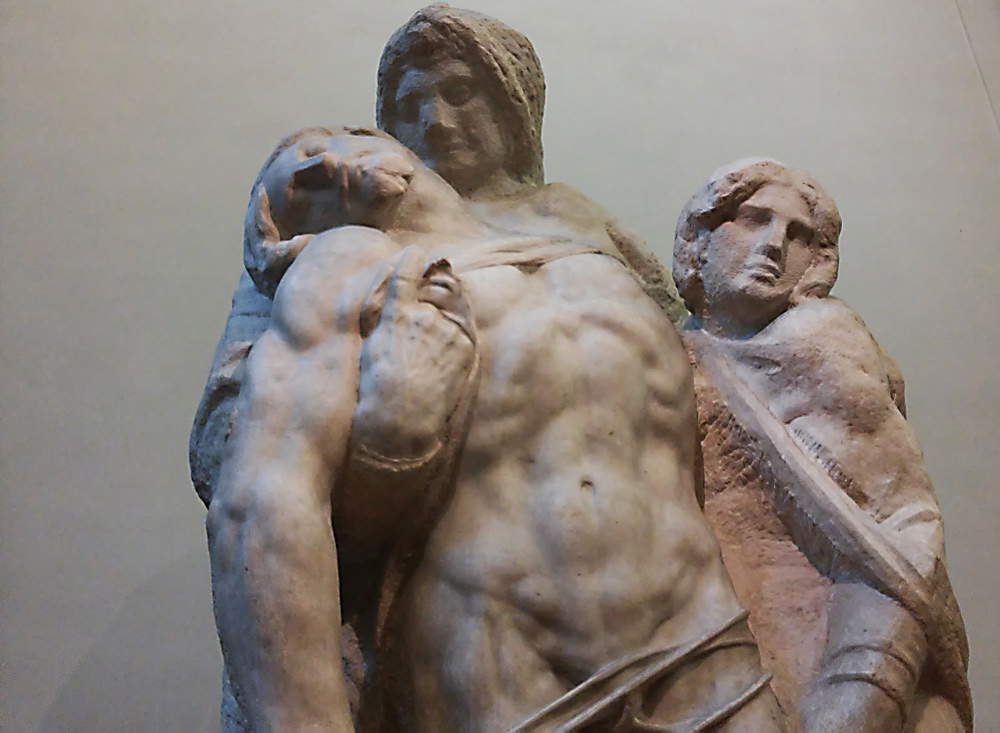 |
| Detail of Palestrina’s Pieta |
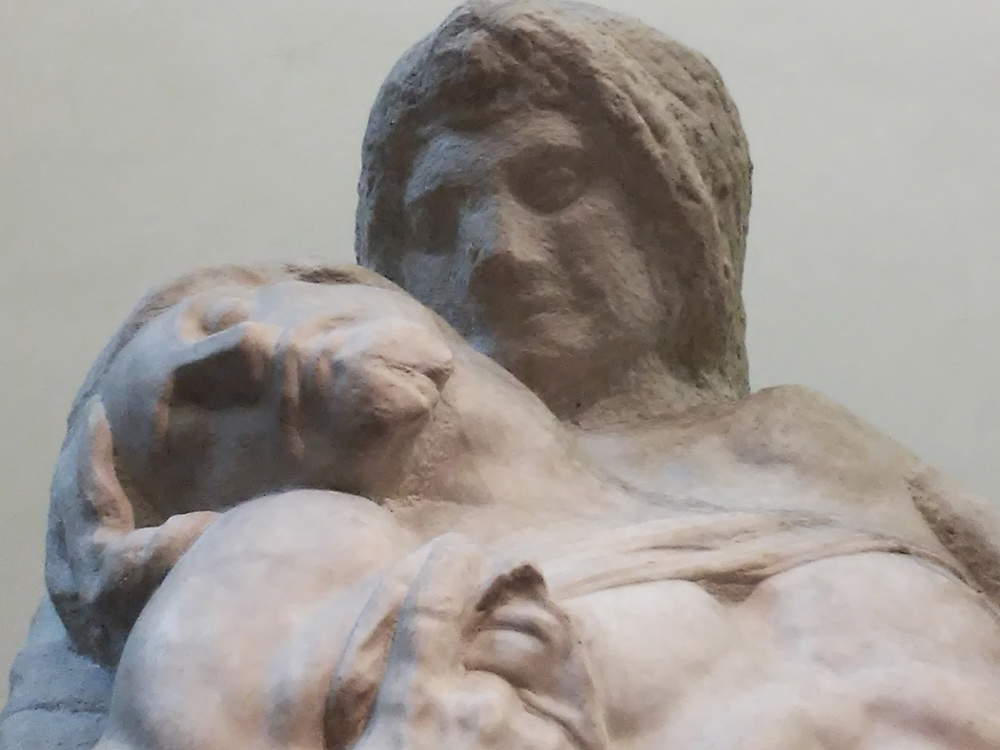 |
| The faces of Jesus and Mary |
A work like Palestrina’s Pieta could not fail to arouse the great curiosity of virtually all the greatest scholars of the first half of the 20th century. The first to deal with it was Frenchman Albert Grenier, who in 1907 wrote the first article devoted to the group(Une “Pietà ” inconnue de Michel-Ange à Palestrina, published in the Gazette des beaux-arts): according to the transalpine scholar, many elements were to be considered revelatory of Michelangelo’s hand (the “violence of the artist’s feeling,” the “tormented attention to detail,” the “profound feeling of the whole,” and even the disproportions, such as the very strong ones between Christ’s chest and legs, which for Grenier are intentional), although the total silence of the sources did not depose in favor of the attribution. Of this, Grenier was perfectly aware: however, he believed that such silence was the only argument against assigning the Palestrina Pieta to Michelangelo. Of the same opinion proved to be the aforementioned Pietro Toesca: his article, while opening with encomiastic tones towards the Duce, had the merit of seeking supports for the attribution to Michelangelo within the graphic production of the great artist. In particular, Toesca wanted to find “very close” kinship relations with the Pieta in a sheet preserved at theAshmolean Museum in Oxford (inventory WA1846.88): the scholar saw in the abandonment of Christ and in the strength of the figure supporting him the main grounds for tangency between the drawing and the sculpture. Valerio Mariani, too, agreed with Toesca’s theses: the Roman scholar also wanted to find hooks in the frescoes of the Sistine Chapel, and in particular in the Last Judgment, where the figure of the risen Christ in the lower left corner being lifted up by an angel holding him under his armpits would reveal remarkable similarities with the Palestrina group. Also arguing in favor of the attribution was Adolfo Venturi, who wrote an article on the Pieta on the occasion of its first exhibition in Florence in 1939.
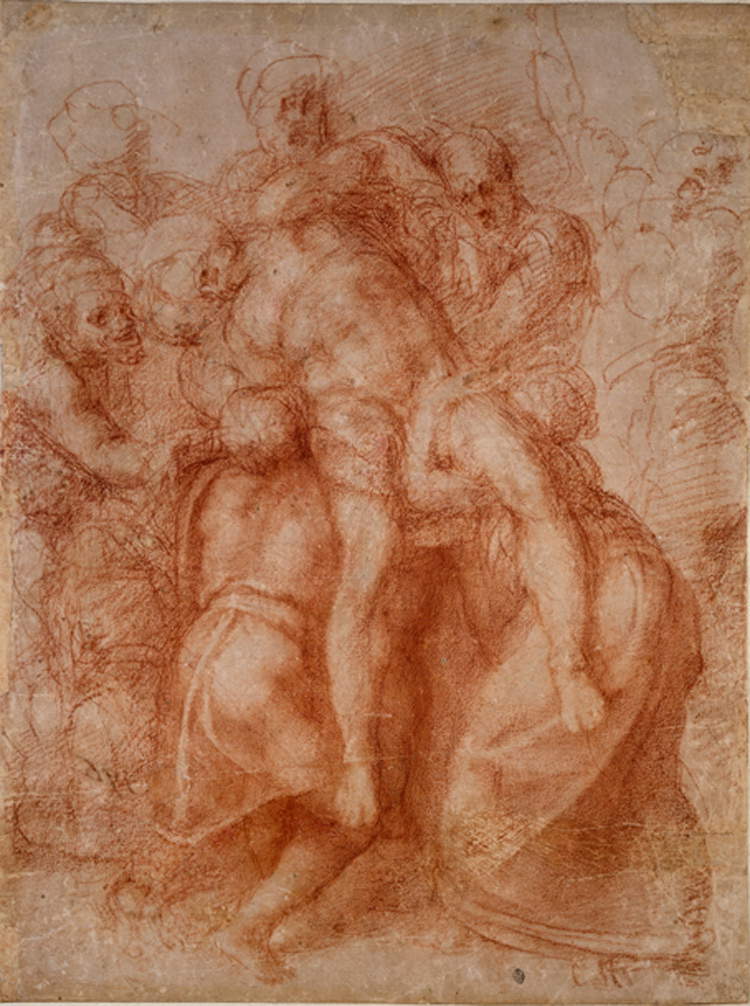 |
| Michelangelo, Study for a Deposition (c. 1555; sanguine drawing on paper, 37.5 x 28 cm; Oxford, Ashmolean Museum) |
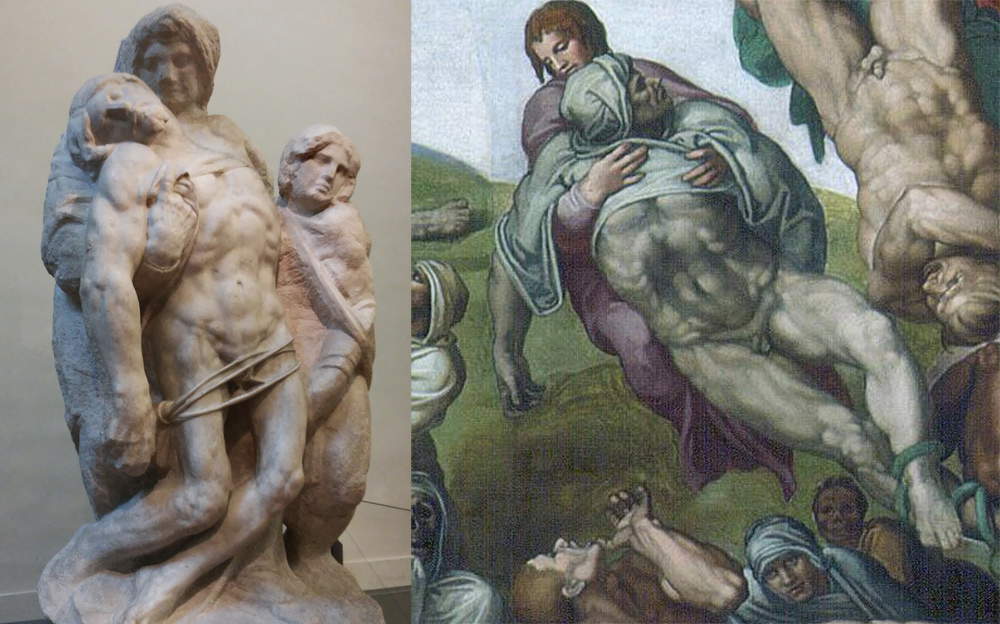 |
| Palestrina’s Pieta compared with the Last Judgment group. |
There were not a few who, on the contrary, expressed perplexity about Michelangelo’s name or, at least, about the total execution by the master. Right from the start: as early as 1908, the German Henry Thode had advanced reservations on the grounds that, although he had not seen the work live but had judged it from photographs, he considered it to be of a quality not up to the standard of a sculpture by Michelangelo (especially the Madonna had appeared to him to be too clumsy to have been produced by the hand of the master). Still, the spirit was that of the Tuscan artist: probable, according to Thode, that it was an imitator. Thode’s voice was soon joined by others: for example, that of Anny E. Popp, who in 1926 published an article in which she came to the same conclusion as her colleague, namely that Palestrina’s Pietà was the work of an imitator, or that of Rudolf Wittkower, who thought the work of a pupil. An opinion that dealt a blow to the supporters of Michelangelo’s attribution came in 1951 from one of the greatest experts ever on Michelangelo’s art, the Hungarian Charles de Tolnay (who, moreover, directed the Casa Buonarroti from 1965 to 1981), who wrote that the work was nothing more than “a mixture of motifs from different works by Michelangiolo.” and specifically that “the corpse of Christ and the Virgin are copies of the first version of the Rondanini Pietà ,” that “the Saint Magdalene is a copy (in reverse) of the Magdalene of the Pietà of the Duomo,” and that “the execution, very weak in detail, is probably to be attributed to a pupil of Michelangiolo.” And again, “there is no noticeable transition between the realism of the detailed parts and the unfinished parts,” “the modeling of the surface is quite different from Michelangiolo’s originals,” and “the block is flattened, when by contrast we know that Michelangiolo would have chosen a thicker block.” Tolnay’s opinion was followed by others who tried to provide a “mediation”: in this groove we find, for example, Franco Russoli and Luigi Grassi, according to whom the idea behind the work was to be attributed to Michelangelo, but the execution to one of his collaborators. At the same time there were also those who tried to propose an alternative name: for example, John Pope-Hennessy, who in 1964 even thought of a work by a seventeenth-century artist, Niccolò Menghini, or Alessandro Parronchi, who advanced in 1968 the name of Francesco da Sangallo. One of the opinions that we can consider definitive came from Giorgio Bonsanti in 1987: In his guide to the Accademia Gallery, the scholar wrote that the work is probably “a conscious imitation of Michelangelo’s poetic world, seen, however, from the outside and suffering from its untranslatability,” adding that “the plastic group turns out to be highly problematic and therefore of the greatest interest, perhaps not in the documentation of Michelangelo’s personal activity, but certainly that of a close circle of followers who drank from his complex world of thought.”
Since then, the critical fortunes of the Palestrina Pietà have plummeted: the knot over the sculptor who executed it has not yet been resolved, but neither does there seem to be much interest in a sculptural group that has now been removed from the catalog of Michelangelo’s works and is presented generically at the Accademia Gallery as “attributed to Michelangelo.” In addition to all that, doubts remain about the work’s presence in Palestrina: since it was in the church attached to the Palazzo dei Barberini, it is conceivable that the sculpture came to the town at the foot of the Prenestini Mountains after 1630, when the fiefdom of Palestrina passed from the Colonna to the Barberini. But nothing forbids thinking the opposite, that is, that the work belonged instead to the Colonnas and passed to the Barberinis along with the entire palace of Palestrina: no documents have been found in the archives that could convey even some clues. Obviously, given the total silence of the sources, it is also difficult to formulate a dating: most are, however, inclined to place it in the 1650s (in the captions of this article the dating of the official guide to the last Galleria dell’Accademia, edited by Franca Falletti, has been used). However, we can safely avoid believing that “Michelangiolo” inscribed with granitic conviction on the base of the Pieta.
Reference bibliography
- Roberta Iacono (ed.), The Church of Santa Rosalia. The chapel of the Barberini princes in Palestrina, Edizioni Articolo Nove, 2015
- Franca Falletti, Marcella Anglani, Gabriele Rossi Rognoni, Galleria dell’Accademia. Official guide, Giunti, 2012 (first edition 1999)
- Adriano Amendola, Michelangelo: un affare di Stato in Maria Giulia Aurigemma, Dal Razionalismo al Rinascimento. For the forty years of studies of Silvia Danesi Squarzina, Campisano Editore, 2011(download)
- Giorgio Bonsanti, The Academy Gallery, Scala, 1987
- Eugenio Battisti, Michelangelo scultore, De Agostini, 1981
- Umberto Baldini, The Complete Works of Michelangelo the Sculptor, Rizzoli, 1973
- Charles de Tolnay, Michelangelo: The final period, Princeton University Press, 1969
- Henry Thode, Michelangelo, kritische Untersuchungen über seine Werke, G. Grotesche Verlagsbuchhandlung, 1908
Warning: the translation into English of the original Italian article was created using automatic tools. We undertake to review all articles, but we do not guarantee the total absence of inaccuracies in the translation due to the program. You can find the original by clicking on the ITA button. If you find any mistake,please contact us.




























